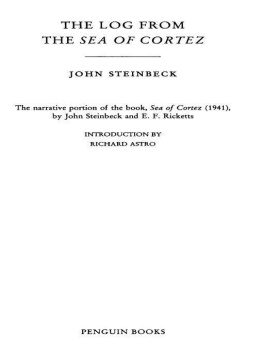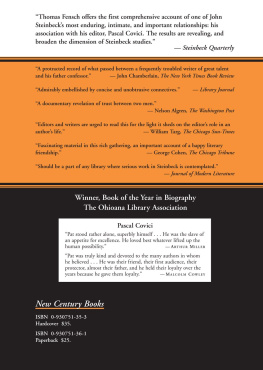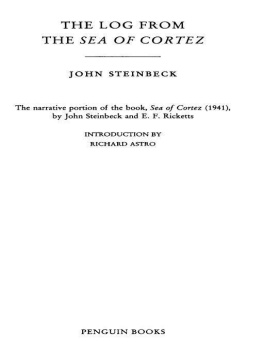Table of Contents
THE LOG FROM THE SEA OF CORTEZ
Born in Salinas, California, in 1902, John Steinbeck grew up in a fertile agricultural valley about twenty-five miles from the Pacific Coastand both valley and coast would serve as settings for some of his best fiction. In 1919 he went to Stanford University, where he intermittently enrolled in literature and writing courses until he left in 1925 without taking a degree. During the next five years he supported himself as a laborer and journalist in New York City, all the time working on his first novel, Cup of Gold (1929). After marriage and a move to Pacific Grove, he published two California books, The Pastures of Heaven (1932) and To a God Unknown (1933), and worked on short stories later collected in The Long Valley (1938). Popular success and financial security came only with Tortilla Flat (1935), stories about Montereys paisanos. A ceaseless experimenter throughout his career, Steinbeck changed courses regularly. Three powerful novels of the late 1930s focused on the California laboring class: In Dubious Battle (1936), Of Mice and Men (1937), and the book considered by many his finest, The Grapes of Wrath (1939). Early in the 1940s, Steinbeck became a filmmaker with The Forgotten Village (1941) and a serious student of marine biology with Sea of Cortez (1941). He devoted his services to the war, writing Bombs Away (1942) and the controversial play-novelette The Moon Is Down (1942). Cannery Row (1945), The Wayward Bus (1948), another experimental drama, Burning Bright (1950), and The Log from the Sea of Cortez, (1951) preceded publication of the monumental East of Eden (1952), an ambitious saga of the Salinas Valley and his own familys history. The last decades of his life were spent in New York City and Sag Harbor with his third wife, with whom he traveled widely. Later books include Sweet Thursday (1954), The Short Reign of Pippin IV: A Fabrication (1957), Once There Was a War (1958), The Winter of Our Discontent (1961), Travels with Charley in Search of America (1962), America and Americans (1966), and the posthumously published Journal of a Novel: The East of Eden Letters (1969), Viva Zapata! (1975), The Acts of King Arthur and His Noble Knights (1976), and Working Days: The Journals of The Grapes of Wrath (1989). He died in 1968, having won a Nobel Prize in 1962.
Richard Astro is professor of English at the University of Central Florida, where he is also director of the Eastern Europe Linkage Institute. He is the author of John Steinbeck and Edward F. Ricketts: The Shaping of a Novelist, as well as studies on Hemingway, Fitzgerald, and western American literature.
PENGUIN BOOKS
Published by the Penguin Group
Penguin Group (USA) Inc., 375 Hudson Street, New York, New York 10014, U.S.A.
Penguin Group (Canada), 90 Eglinton Avenue East, Suite 700, Toronto,
Ontario, Canada M4P 2Y3 (a division of Pearson Penguin Canada Inc.)
Penguin Books Ltd, 80 Strand, London WC2R ORL, England
Pengum Ireland, 25 St Stephens Green, Dublin 2, Ireland (a division of Penguin Books Ltd)
Penguin Group (Australia), 250 Camberwell Road, Camberwell,
Victoria 3124, Australia (a division of Pearson Australia Group Pry Ltd)
Penguin Books India Pvt Ltd, 11 Community Centre, Panchsheel Park, New Delhi - 110 017, India
Penguin Group (NZ), cnr Airborne and Rosedale Roads,
Albany, Auckland 1310, New Zealand (a division of Pearson New Zealand Ltd)
Penguin Books (South Africa) (Pty) Ltd, 24 Sturdee Avenue,
Rosebank, Johannesburg 2196, South Africa
Penguin Books Ltd, Registered Offices: 80 Strand, London WC2R ORL, Englan
Sea of Cortez first published in the United States of America
by The Viking Press 1941
The Log from the Sea of Cortez first published by The Viking Press 1951
Published in Penguin Books 1977
This edition with an introduction by Richard Astro
published in Penguin Books 1995
Sea of Cortez
Copyright John Steinbeck and Edward F. Ricketts, 1941 Copyright renewed John Steinbeck and Edward F. Ricketts, Jr., 1969
All rights reserved
The Log from the Sea of Cortez
Copyright John Steinbeck, 1951
Copyright renewed Elaine Steinbeck, John Steinbeck IV and Thom Steinbeck, 1979
Introduction copyright Richard Astro, 1995
All rights reserved
LIBRARY OF CONGRESS CATALOGING-IN-PUBLICATION DATA
Steinbeck, John, 1902-1968.
[Sea of Cortez]
The log from the Sea of Cortez/John Steinbeck; introduction by
Richard Astro.
p. cm.
The narrative portion of the book, Sea of Cortez (1941), by John
Steinbeck and E. F. Ricketts.
Originally published: New York: Viking, 1951.
Appendix: About Ed Ricketts: p.
Includes bibliographical references and index.
eISBN: 9781101398890
1. Marine invertebratesMexicoCalifornia, Gulf of.
2. California, Gulf of (Mexico)Description and travel.
3. Steinbeck, John, 1902-1968JourneysMexicoCalifornia, Gulf
of. 4. Ricketts, Edward Flanders, 1896-1948JourneysMexico
California, Gulf of. I. Ricketts, Edward Flanders, 1896-1948.
II. Steinbeck, John, 1902-1968. About Ed Ricketts. III. Title.
QL225.S74 1995
508.31641dc20 95-14802
http://us.penguingroup.com
INTRODUCTION
In February 1995, a large and diverse group of Californians, most of them at least in their mid-seventies, gathered on Cannery Row to celebrate the fiftieth anniversary of the publication of Steinbecks novel of the same name, and otherwise to reminisce about the two men who made the Row famous: the novelist himself and his closest personal and intellectual companion, marine biologist Edward F. Ricketts. The event was billed as a symposium, and was co-sponsored by the Cannery Row Foundation and Steinbeck Research Center at San Jose State University. But given the list of participantsIncluding two of Rickettss children; Joel Hedgpeth, senior curmudgeon of the California intertidal; Virginia Scardigli, former teacher and friend of both Steinbeck and Ricketts; Alan Baldrige, for many years the librarian at Stanford Universitys Hopkins Marine Station on Ocean Avenue near the Row; and Robert Enea, a nephew of two of the crew members from the Sea of Cortez expeditionthe event was less a symposium than a giant party. And this seemed an appropriate way to commemorate the publication of the book in which Steinbeck wrote that every party has its own pathology, and that a party hardly ever goes the way it is planned or intended. Of course, that books leading character is a fictionalized version of Steinbecks closest friend and his collaborator on Sea of Cortez his most important work of nonfiction, a volume which contains the core of Steinbecks worldview, his philosophy of life, and the essence of a relationship between a novelist and a scientist that ranks among the most famous friendships in American letters. If many tall tales were told at the symposium, embellished by years of telling, it made no difference, except to enhance the festivities. For whatever the excesses, the surviving few from the Steinbeck-Ricketts years knew and talked about the breadth and depth of a friendship that was deep and permanent, and that, because of the impact of Rickettss thinking on Steinbecks most important fiction, accounts in large measure for the novelists success as a writer.
Cannery Row was published five years after the Steinbeck-Ricketts expedition to the Gulf of California, and while Rickettss life in Monterey remained largely unchanged afterward (he was drafted into the army during World War II, but never left the Monterey presidio), Steinbeck departed California altogether. His marriage to his first wife, Carol, ended. He romanced Hollywood singer Gwen Conger, married her in New Orleans, joined the war effort as a correspondent for the New York Herald Tribune, wrote a novelette about the war entitled The Moon Is Down (1942) and some propaganda pieces for the Army Air Corps that were later published as Bombs Away (1943), bought a brownstone on Manhattans East Side, and gradually became a New Yorker. He and Ricketts communicated by mail, but they hardly ever saw each other again.















